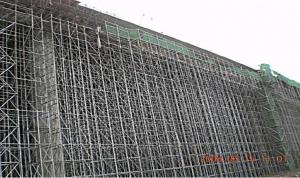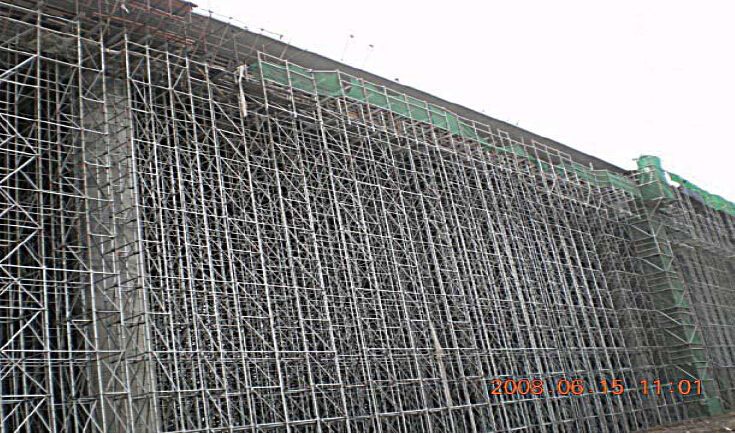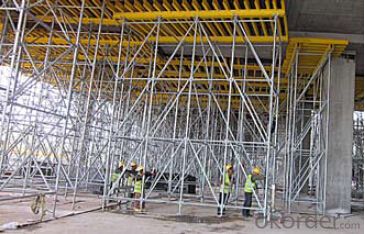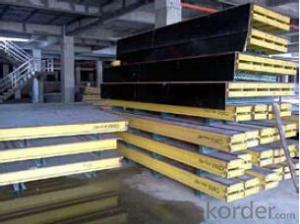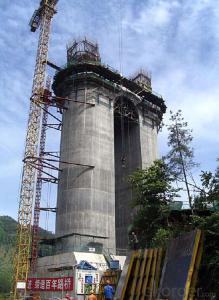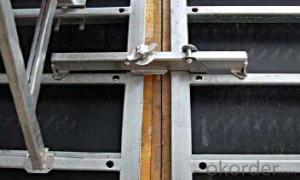Tower-Scaffolding for Formwork and Scaffolding systems
- Loading Port:
- Tianjin
- Payment Terms:
- TT OR LC
- Min Order Qty:
- 50 m²
- Supply Capability:
- 1000 m²/month
OKorder Service Pledge
Quality Product, Order Online Tracking, Timely Delivery
OKorder Financial Service
Credit Rating, Credit Services, Credit Purchasing
You Might Also Like
Tower Scaffolding
Shoring tower is an effective supporting system. It is easy to assemble and dismantlement, and
has excellent stability and bearing capacity. It has been widely used in the construction of industry
& residential buildings , bridges, tunnels and dam project, etc.
Characteristics:
◆ High degree of standardization.
◆ Easy storage and transportation
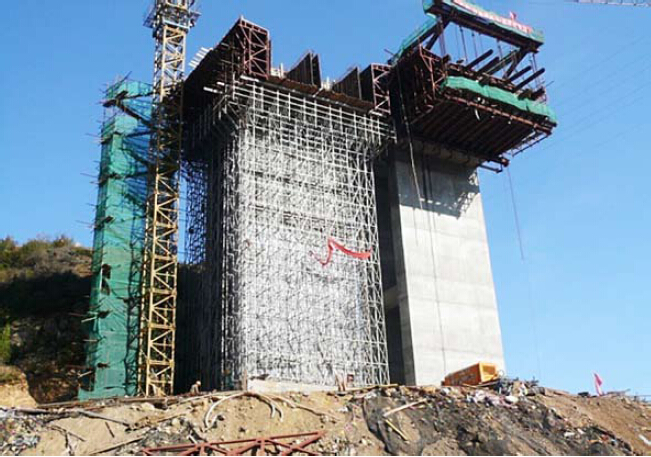
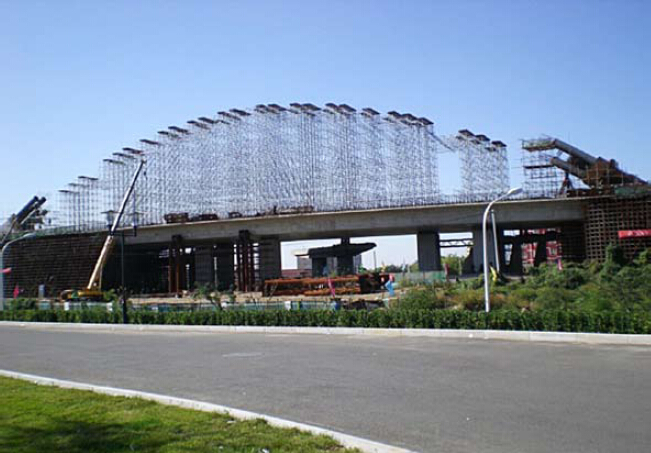
- Q: How does steel formwork affect the overall thermal performance of the structure?
- The overall thermal performance of a structure can be significantly affected by steel formwork. The thermal conductivity of steel is the main factor that influences this. Steel, with its high thermal conductivity, easily transfers heat from one side to the other. When constructing a building with steel formwork, it acts as a thermal bridge between the interior and exterior of the structure. This can lead to heat transfer across the steel formwork, resulting in increased heat loss or gain depending on the external temperature. In colder climates, steel formwork can contribute to higher heat loss, resulting in increased energy consumption for heating. Similarly, in warmer climates, steel formwork can allow heat to transfer into the building, leading to increased cooling requirements. To mitigate this thermal bridging effect, various measures can be taken. One approach is to use thermal breaks, which involve placing insulating materials between the steel formwork and the rest of the structure. These breaks help reduce the heat transfer through the steel, thereby improving the overall thermal performance. Another approach is to use alternative formwork materials with lower thermal conductivity, such as insulated concrete forms (ICFs) or wood. Considering the thermal performance of steel formwork during the design and construction phases is important to ensure energy efficiency and occupant comfort. By implementing proper insulation and thermal breaks, the negative impact of steel formwork on the overall thermal performance of the structure can be minimized.
- Q: What are the different surface finishes available for steel formwork?
- There are several surface finishes available for steel formwork, including smooth, textured, and coated finishes. Smooth finishes provide a sleek and polished appearance, while textured finishes create a rougher surface for enhanced grip and adhesion. Coated finishes, such as epoxy or galvanized coatings, offer additional protection against corrosion and wear.
- Q: Can steel formwork be used for architectural features?
- Yes, steel formwork can be used for architectural features. Steel formwork provides strength, durability, and flexibility, making it suitable for creating complex and intricate architectural designs. It allows for precise shaping, smooth finishes, and efficient construction processes, making it a popular choice for architectural features such as decorative facades, columns, beams, and other structural elements.
- Q: Are there any specific considerations for using steel formwork in areas with high humidity?
- Yes, there are specific considerations for using steel formwork in areas with high humidity. Steel formwork is prone to corrosion when exposed to high levels of moisture in the air. Therefore, it is essential to protect the steel formwork with appropriate coatings or sealants to prevent rust and degradation. Regular inspections and maintenance should also be carried out to ensure the formwork remains in good condition and to address any signs of corrosion promptly. Additionally, selecting the right type of steel and ensuring proper ventilation and drying of the formwork can help mitigate the effects of high humidity on its performance and longevity.
- Q: How does steel formwork affect the overall material wastage in construction?
- Construction projects can greatly reduce material wastage by using steel formwork. Unlike traditional timber formwork, which is typically discarded after each use, steel formwork can be reused multiple times. This reduces the need for new materials like timber, plywood, or plastic, which would otherwise contribute to material wastage. In addition, steel formwork is highly durable and can withstand harsh weather conditions, impacts, and vibrations. This durability ensures that the formwork remains intact and functional for a longer period, reducing the need for frequent replacements and further minimizing material wastage. Furthermore, steel formwork is highly customizable and can be easily adjusted and modified to fit different project requirements. This flexibility allows for precise shaping and molding of concrete structures, resulting in reduced material wastage. Timber formwork, on the other hand, can be challenging to use for achieving complex shapes or curves, leading to excessive cutting and wastage. Moreover, steel formwork offers excellent dimensional stability, ensuring accurate and consistent concrete placement. This eliminates the need for rework, which can result in material wastage. Additionally, steel formwork provides a smooth surface finish, reducing the requirement for additional finishing materials like plaster, which again minimizes material wastage. Overall, the use of steel formwork in construction projects can significantly reduce material wastage. Its reusability, durability, flexibility, dimensional stability, and smooth surface finish contribute to optimizing material usage, minimizing the need for new materials, and ultimately reducing overall material wastage.
- Q: How does steel formwork affect the overall sustainability of a construction project?
- Steel formwork can have a significant impact on the overall sustainability of a construction project. Firstly, steel formwork is highly durable and reusable, which reduces the need for constant replacement and minimizes waste generation. This not only reduces the project's environmental footprint but also helps in cost reduction. Moreover, steel formwork provides a high level of accuracy and precision, resulting in efficient and streamlined construction processes. This leads to reduced material wastage and energy consumption, contributing to the sustainable use of resources. Additionally, the use of steel formwork enables faster construction cycles, which can reduce the project's overall energy consumption and greenhouse gas emissions. Steel formwork also offers versatility in design, allowing for complex and innovative architectural structures. This versatility can enhance the aesthetic appeal of a building, promoting its long-term use and reducing the likelihood of demolitions due to outdated designs. By extending the lifespan of a structure, steel formwork contributes to the sustainability of the project by reducing the need for additional construction and material usage. Furthermore, steel formwork can contribute to the overall structural integrity and safety of a building. Its strength and rigidity ensure stability during construction and throughout the lifespan of the structure. This reduces the likelihood of structural failures and the need for repairs or reconstruction, thereby minimizing waste generation and resource depletion. In summary, steel formwork positively impacts the overall sustainability of a construction project through its durability, reusability, precision, efficiency, versatility, and structural integrity. By reducing waste generation, energy consumption, and greenhouse gas emissions, steel formwork promotes the sustainable use of resources and contributes to the long-term viability of buildings.
- Q: What are the different types of joints used with steel formwork?
- Steel formwork joints in construction projects can be categorized into different types, each serving a specific purpose. These joints are crucial for ensuring stability, strength, and ease of assembly and disassembly. Here are some commonly used joints: 1. Straight Sections: For connecting straight sections of formwork, a simple butt joint is employed, where the edges of two steel formwork sections are placed together. 2. Longer Sections: To provide additional strength for longer sections of formwork, a lap joint is used. In this joint, one formwork section overlaps another, creating a strong connection. 3. Adjustable and Repositionable: A clamped joint utilizes clamps or bolts to securely fasten the formwork sections together. This joint allows for easy adjustment and repositioning of the formwork. 4. Vertical and Horizontal Connections: A wedge joint is commonly used to connect vertical and horizontal formwork sections. It involves inserting a wedge-shaped piece into a slot to create a secure connection. 5. Large and Heavy Components: A flanged joint is created by using flanges or plates on the formwork sections, which overlap and are bolted together. This joint provides a strong connection and is ideal for large and heavy formwork components. 6. Quick Assembly and Disassembly: For quick and easy assembly and disassembly of formwork sections, a pin joint is utilized. Pins or dowels are used to connect the formwork sections securely. Selecting the appropriate joint type is essential and should be based on the specific requirements of the construction project. Factors such as formwork design, load-bearing capacity, ease of assembly, and reusability are crucial in determining the suitable joint choice.
- Q: How does steel formwork compare to timber formwork?
- Steel formwork is often preferred over timber formwork in construction projects for several reasons. Firstly, steel formwork is much more durable and long-lasting compared to timber formwork. Steel is a strong and resilient material that can withstand heavy loads and harsh weather conditions, making it suitable for multiple uses and reducing the need for frequent replacements. In terms of strength, steel formwork offers greater structural integrity and stability. It can withstand higher concrete pressures, allowing for the construction of taller and more complex structures. This is particularly beneficial in high-rise buildings or projects that require large spans. Steel formwork also offers better dimensional accuracy and consistency. Unlike timber, steel formwork does not warp or distort over time, ensuring that the final concrete structure maintains its intended shape and dimensions. This can save time and effort during the construction process, as there is less need for adjustments or corrections. Additionally, steel formwork is easier to clean and maintain. It does not absorb moisture or harbor pests like timber does, reducing the risk of deterioration or contamination. Moreover, steel formwork can be easily reused multiple times, making it a more sustainable and cost-effective option in the long run. However, it is important to note that steel formwork generally requires more specialized equipment and skilled labor for assembly and disassembly compared to timber formwork. This may result in higher initial costs and longer setup times for projects. Furthermore, steel formwork may not be suitable for certain applications where weight is a concern, as it is generally heavier than timber. Overall, while both steel and timber formwork have their advantages and disadvantages, steel formwork is often favored in construction due to its durability, strength, dimensional accuracy, and ease of maintenance.
- Q: What type of finishes can be achieved with steel formwork?
- Steel formwork can achieve a variety of finishes, including smooth, textured, and patterned surfaces. Additionally, steel formwork allows for precise and intricate detailing, making it possible to achieve complex shapes and designs in concrete structures.
- Q: Can steel formwork be used in areas with high wind loads?
- Yes, steel formwork can be used in areas with high wind loads. Steel formwork is known for its strength, durability, and stability, making it a suitable choice for construction projects in areas with high wind loads. The robustness and rigidity of steel formwork allow it to withstand the force and pressure exerted by strong winds, ensuring the safety and stability of the structure being built. Additionally, steel formwork offers a higher level of resistance to deformation and movement compared to other types of formwork materials, making it more reliable in areas prone to high wind loads. However, it is crucial to ensure that the steel formwork is properly secured and anchored to the ground to further enhance its resistance against wind loads.
Send your message to us
Tower-Scaffolding for Formwork and Scaffolding systems
- Loading Port:
- Tianjin
- Payment Terms:
- TT OR LC
- Min Order Qty:
- 50 m²
- Supply Capability:
- 1000 m²/month
OKorder Service Pledge
Quality Product, Order Online Tracking, Timely Delivery
OKorder Financial Service
Credit Rating, Credit Services, Credit Purchasing
Similar products
Hot products
Hot Searches
Related keywords
